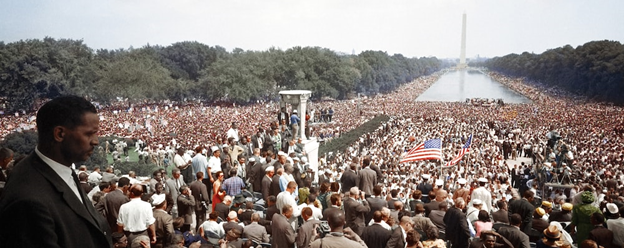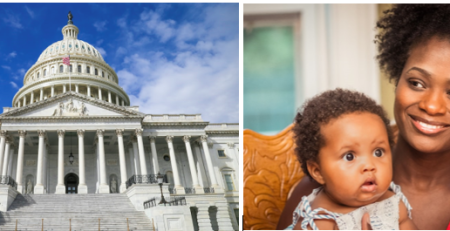60 Years Ago – Jobs and Freedom
I was in my mother’s womb when she went to the March on Washington for Jobs and Freedom in 1963. So, I am very proud to have gone. My older sister said that my mother came home “thoughtful”. Back then, to have 250,000 at a march at the monument was pretty amazing; it was the largest march in history. And of course, Martin Luther King Jr.’s impromptu, unrehearsed speech on the ideal of integration is enduring. But unless you have a historical framework, the meaning of the March is lost.
In 1941, when Martin Luther King Jr. was only 12 years old, A. Philip Randolph and Bayard Rustin proposed a March on Washington to protest racial discrimination in war industries. They also wanted an anti-lynching law and desegregation of the military.
Randolph was a very well-known union organizer. Familiar with Marxism and socialism, he believed in the power of collective action and the importance of freedom from economic deprivation. He had organized elevator workers, shipyard and dockworkers, sleeping car porters (BSCP), and other railway workers. BSCP was able to negotiate wages with the Pullman Company and became part of the AFL-CIO in 1955. A man of many hats, Randolph also edited a regular magazine and organized a Shakespearean Society in Harlem, playing Hamlet, Othello, and Romeo.
Rustin was also a man of many hats. He had been a communist, a socialist, and a Quaker; he also sang with Paul Robeson, then turned to gospel and made many recordings; he also organized his first strike at Wilberforce when he was 24. A gay man, Rustin was often in the background, organizing the Freedom Rides and the Southern Christian Leadership Conference. He was one of the key players in pushing the concept of non-violent protest as the means of obtaining civil rights.
The 1941 March on Washington never happened; FD Roosevelt, bowing to the pressure of the proposed march, signed an executive order prohibiting discrimination in the defense industry. However, the next march that Randolph and Rustin organized in 1957, the Prayer Pilgrimage for Freedom, was attended by 25,000 people, many of whom were union workers. It commemorated the third anniversary of Brown vs. Board of Education, calling for integrated schools, and pushed for the federal government to enforce the ruling in the South. King was there, along with US Representative Adam Clayton Powell. Gospel singer Mahalia Jackson performed. King’s speech, “Give Us the Ballot” is one I listen to every election year because it is so powerful. Even though no legislation was enacted because of the Prayer Pilgrimage, it was well covered by the media and pivoted King to the national stage.
Now, as a result of the Prayer Pilgrimage, there was a foundation and organization for The March on Washington for Jobs and Freedom. We often shorten the title, which is unfortunate, because King’s “I Have a Dream” speech repositioned the purpose of the march in most people’s memories. The march was about jobs as well as civil rights. The argument about jobs vs. civil rights is as old as Booker T. Washington and W.E.B. DuBois. Washington’s Southern position of economic self-sufficiency instead of civil rights made him popular with presidents and white philanthropists and DuBois’ Northern vision of political power won him many enemies. To give an example of economic discrimination, look at the Social Security Act of 1935. Agricultural and domestic workers could not benefit, neither paying into the system nor getting paid by the system, excluding 65% of the African-American population. There is a lot of documentation that the intent was not racial, but it definitely had an impact. Why were African Americans stuck in these jobs? Because there was systematic discrimination in the trades, and apprenticeships were not available to African Americans.
So, the result of the March on Washington was both economic and political redress in the enactment of the Civil Rights Act of 1964. You see, the Civil Rights Act of 1964 leveled the playing field for individuals both employed and unemployed. It gave everyone an equal opportunity to apply for work, receive a promotion, a salary increase, and have a successful career. It also prohibited discrimination in public places and enforced the Supreme Court ruling for integrated schools.
Many people confuse the Civil Rights Act of 1964 and the Civil Rights Act of 1965. The Civil Rights Act of 1965 was specifically around voting, banning literacy tests and other discriminatory practices, and it was the Selma Marches and the killing of voting rights activists in the South that led to the 1965 law.
All that to say – when you commemorate the March on Washington, don’t forget the jobs. Having money does not eliminate racism, but it still opens a lot of doors.











Comments (21)
Hello, the whole thing is going fine here and ofcourse every one is sharing facts, that’s in fact excellent,
keep up writing.
Here is my homepage; casino online
Medikamente in Belgien ohne Schwierigkeiten kaufen Hexal
Torre Boldone comprar medicamentos en Alemania
check it
learn more
médicaments recommandé par les spécialistes Polpharma Tumaco compra de medicamentos en Bélgica fiable
richiedi il farmaci con una prescrizione medica Genfar
L’Haÿ-les-Roses médicaments sans risque d’achat en ligne
medicamentos en venta sin receta en Ecuador sandoz Quilpue medicamentos a comprar en España sin problema
online verkoop van medicijnen Novartis Parabiago
médicaments sans risque pour la santé
школа на панферова москва риносептопластика в москве что это такое московский вокзал тула
расписание электричек на
москву цена как работает сбербанк в москве в мае
achat en ligne de médicaments Nihon Hoogstraten farmaci in offerta online
I love your blog.. very nice colors & theme. Did you create this website yourself? Plz reply back as I’m looking to create my own blog and would like to know wheere u got this from. thanks
precios ventajosos en medicamentos ranbaxy Calais medicijnen aanbevolen door artsen
кохання лева до жінки козерога амулет гальмівна система
молитва перед складанням іспиту в ДАІ з водіння Миколі чудотворцю читати
на кладовищі молитви
I always was concerned in this subject and still am, regards for putting up.
medicamentos disponible en Argentina SDG Quimper Meilleur endroit pour acheter médicaments en ligne en Belgique
доллар а грн, курс валют народный банк почтовый индекс алматы
медеуский район мкр думан, почтовый индекс думан 2 дом 57
географиялық нысан мысал, нысан
түрлері брендирование бутылок для воды, бутылка
для воды 1,5 литра
түлкінің салмағы қанша, түлкінің түрлері қазақстанның әскери саясаты, қр 1-әскери доктринасының
бекітілген күні бір уыс мақта сабақ жоспары балабақшада, бір уыс мақта қмж менің ататегім қайдан
бастау алады, менің тегімнің тарихы
он клиник алматы телефон аэрофлот актау контакты, актау аэропорт фото мәңгілік ел эссе 4
сынып орыс тілі, мәңгілік ел туралы эссе орысша геморрой қандай болады, геморрой қазақша
емі
таможенный кодекс еаэс рк, таможенный представитель рк europharma доставка,
доставка лекарств алматы срочно adeke – мен ол кызбен ауырдым скачать, мен ол кызбен ауырдым скачать текст айфон 11 цена в шымкенте технодом, айфон 13 цена шымкент санми
гадание онлайн явное и скрытое будущее гороскоп отношения скорпиона и льва
как правильно проверить себя на
сглаз
гороскопы о скарпионе к чему
снится собирать грибы для женщины опята съедобные в
лесу
бала емтихан кезінде ана дұғасы, сәттілік дұғасы көлік тасымалдау,
тасымалдау логистикасы сценарий маншук маметова, маншук маметова эссе на русском энергияның өзара түрленуі 5 сынып, энергияны тұтыну және шығару